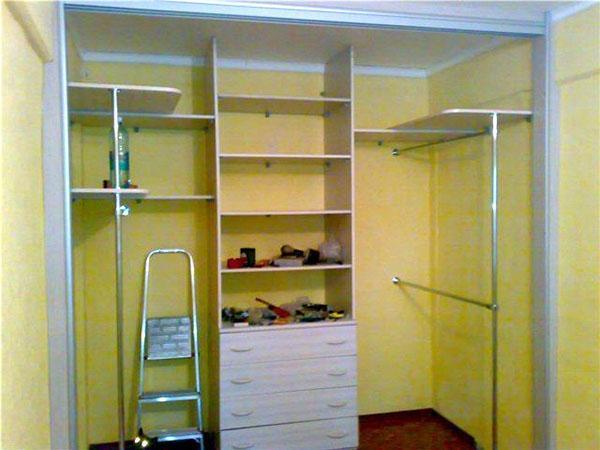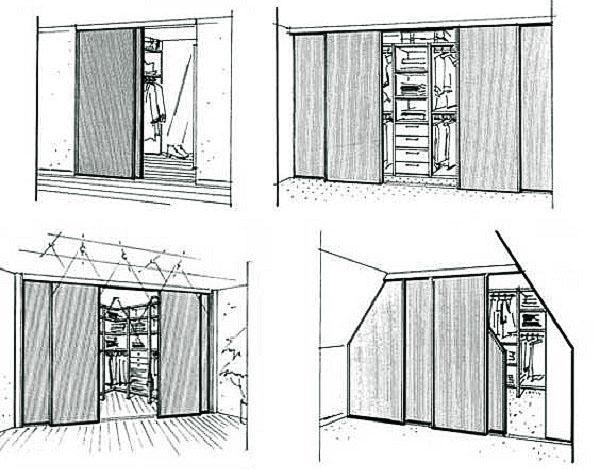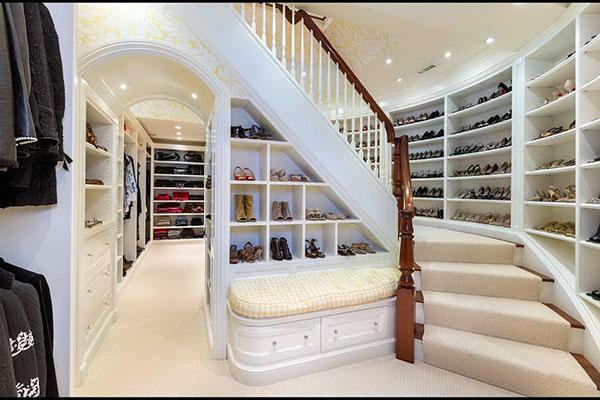Do-it-yourself spacious dressing room
 A do-it-yourself wardrobe is an economical, convenient and functional room for storing clothes and other things. Do not think that such a room is the prerogative of only rich, spacious houses or apartments. You can make a dressing room with your own hands, while saving living space. This design will help the landlord to put things in order among the mass of things.
A do-it-yourself wardrobe is an economical, convenient and functional room for storing clothes and other things. Do not think that such a room is the prerogative of only rich, spacious houses or apartments. You can make a dressing room with your own hands, while saving living space. This design will help the landlord to put things in order among the mass of things.
Among the advantages of using dressing rooms are the following. Do-it-yourself wardrobe system is:
- additional space for an ottoman or an area for trying on clothes and accessories;
- the ability to make an individual area for each family member without buying bulky wardrobes;
- placement of not only shelves for small items of clothing, but also a chest of drawers or additional cavities, drawers for various little things;
- the ability to get rid of bulky furniture, which is difficult to do without in the absence of dressing rooms.
Do-it-yourself dressing room: smart use of space

A dressing room in an apartment is needed to systematize and organize the space intended for storing such things:
- outerwear and casual wear;
- underwear and bedding;
- bags, scarves, gloves, other accessories;
- footwear;
- household items and accessories for the household and more.
For a reasonable use of space in a living room, you should evaluate how large is the area that can be allocated to create a dressing room. At the same time, it is important not to overdo it: a large space allocated for storing clothes unnecessarily reduces the useful living space.
Even for a small apartment, there are several options for arranging a compact dressing room.
Here are a few things to consider when planning a dressing room in a small room:
- If the size of the apartment allows you to make a dressing room with your own hands, using a space of 1.5 * 2 m, you can abandon the doors, replacing them with a curtain.
- To save space, you should equip the dressing room not near one of the walls, but in the corner of the room. A room with a non-standard or low ceiling is also suitable. For example, a section of a rooftop room with a sloped or L-shaped ceiling that would not otherwise be used.
- If swing doors are provided in the dressing room, they should also be done by placing pockets designed to store the necessary little things.
- All possible space should be used. So, for apartments with high ceilings, it is worth using a shelf system that reaches right up to the ceiling. However, you should also consider purchasing a folding ladder.
 When choosing a place for arranging a dressing room, you can pay attention to unoccupied rooms, niches of an unusual shape. If space allows, it is most convenient to place such a storage closet directly in or near the bedroom. In a private house, an excellent solution would be the location of the dressing room in the attic, understairs or in the stairwell.
When choosing a place for arranging a dressing room, you can pay attention to unoccupied rooms, niches of an unusual shape. If space allows, it is most convenient to place such a storage closet directly in or near the bedroom. In a private house, an excellent solution would be the location of the dressing room in the attic, understairs or in the stairwell.
Materials used for the dressing room
 How to make a dressing room with your own hands and what do you need to have for this? For the manufacture of niches, shelves or separation of the wardrobe space from the rest of the room, building material such as drywall is perfect. It can be easily cut into pieces of any shape, simply painted and assembled.If desired, all elements of the dressing room can be made of plasterboard material.
How to make a dressing room with your own hands and what do you need to have for this? For the manufacture of niches, shelves or separation of the wardrobe space from the rest of the room, building material such as drywall is perfect. It can be easily cut into pieces of any shape, simply painted and assembled.If desired, all elements of the dressing room can be made of plasterboard material.
If drywall does not seem solid and durable enough to withstand a lot of things, you can use chipboard or plywood. Chipboard is a sturdy and affordable wardrobe material. With the right assembly, it will serve its owners for many years.
The best physical material for a dressing room is wood.
Sheets made from a single piece of wood are not only durable but also environmentally friendly. They have their own, unique, natural cut pattern, so they can be used even without additional artistic processing or painting. Wood can be used even in children's rooms: unlike glued chipboard, fiberboard - boards, it does not contain glue or other chemicals that can be harmful to health.
Do-it-yourself wardrobes are easy to make using alternative materials: for owners with a limited budget, the use of old furniture will be a salvation. Thus, it is possible to save on costs and at the same time to clear the space of unnecessary, old, bulky cabinets.
In addition to the main material, for walls and shelves in the dressing room you may need:
- hooks;
- shelf holders;
- hangers;
- drawers.
These elements are sold in building supermarkets, in special markets, in hardware stores and are made from modern lightweight but durable plastic, metals and their alloys. Chrome-plated or brushed metal pipes will also find their way into homemade dressing rooms, acting as hanger holders or shelf bases.
Also, filling for the dressing room may include:
- mirrors;
- materials for the care of shoes and clothing.
If you don't want to spend money and time looking for fittings and auxiliary elements, you can choose the filling for cabinets and wardrobes by looking at old cabinets and unused furniture.
Planning and installation
 Arrangement of a dressing room in the pantry 1.2 by 1.5 sq. m or in a large separate room of a spacious residential building requires planning. Before putting a drawing on a sheet of paper or making an approximate drawing indicating the locations of the individual elements of the dressing room, it is worth deciding on the desired capacity.
Arrangement of a dressing room in the pantry 1.2 by 1.5 sq. m or in a large separate room of a spacious residential building requires planning. Before putting a drawing on a sheet of paper or making an approximate drawing indicating the locations of the individual elements of the dressing room, it is worth deciding on the desired capacity. To do this, it is advisable to sort things and at least count their number. The information obtained in this way will make it possible to roughly estimate how much internal volume a dressing room should have.
To do this, it is advisable to sort things and at least count their number. The information obtained in this way will make it possible to roughly estimate how much internal volume a dressing room should have.
 If you need to arrange a large number of things in a relatively small room, rely on wide shelves in the dressing room with a depth of more than 40 cm. They will facilitate the task of placing clothes, since they will fit two stacks of things at once. Don't forget long coats and oversized winter jackets. If there are any, it is imperative for them to provide rods located at a sufficient height in the dressing room.
If you need to arrange a large number of things in a relatively small room, rely on wide shelves in the dressing room with a depth of more than 40 cm. They will facilitate the task of placing clothes, since they will fit two stacks of things at once. Don't forget long coats and oversized winter jackets. If there are any, it is imperative for them to provide rods located at a sufficient height in the dressing room.
Planning a wardrobe room involves choosing the shape of this important and necessary space. A storage room can be one of the following forms:
- angular;
- L-shaped;
- rectangular;
- square;
- pentagonal or other irregular shape.
 The general trend towards the use of individual dressing rooms has been increasing lately. The popularity of this way of storing things is growing. A separate or corner dressing room, created by hand, has already ceased to be something special. Now such a room is not the prerogative of rich people who have a large number of things and a staff of servants.
The general trend towards the use of individual dressing rooms has been increasing lately. The popularity of this way of storing things is growing. A separate or corner dressing room, created by hand, has already ceased to be something special. Now such a room is not the prerogative of rich people who have a large number of things and a staff of servants.
A small do-it-yourself dressing room can be made even in the place of an ordinary pantry.
Lighting and ventilation
 A DIY walk-in closet should have adequate ventilation and adequate lighting. You should pay attention to the presence natural light... If it does not enter the dressing room from the outside, it is worth providing a sufficient number of light sources. In this case, even a mini-dressing room should be illuminated.
A DIY walk-in closet should have adequate ventilation and adequate lighting. You should pay attention to the presence natural light... If it does not enter the dressing room from the outside, it is worth providing a sufficient number of light sources. In this case, even a mini-dressing room should be illuminated.
 Backlighting is necessary not only in order to consider the items chosen before dressing.
Backlighting is necessary not only in order to consider the items chosen before dressing. If the dressing room is large enough to place a large mirror in it, it is imperative to illuminate it around the perimeter or from above by placing a spotlight or lamp.
If the dressing room is large enough to place a large mirror in it, it is imperative to illuminate it around the perimeter or from above by placing a spotlight or lamp.
Ventilation is necessary to eliminate the smell of stale things, which can form in closed rooms in the absence of proper ventilation. It will also help prevent the formation of colonies of pests and mold in the room with your belongings. Properly arranged ventilation will help to avoid dust settling on things that have been idle in the dressing room for a long time.
 It is easy to arrange ventilated dressing rooms. It is enough to make a hole in the upper part of the room (preferably opposite the entrance or door), which will be an exhaust hole. A fan should be inserted into it: air will escape from here. To ensure supply air flows, holes must be made at the bottom, closer to the floor. It should be located on the opposite wall from the fan. If desired, the holes are covered with decorative panels.
It is easy to arrange ventilated dressing rooms. It is enough to make a hole in the upper part of the room (preferably opposite the entrance or door), which will be an exhaust hole. A fan should be inserted into it: air will escape from here. To ensure supply air flows, holes must be made at the bottom, closer to the floor. It should be located on the opposite wall from the fan. If desired, the holes are covered with decorative panels.
Silent fans should be used to extract air, especially when the dressing room is located in a bedroom or in an adjacent room.
For lighting, it is permissible to use several options at once. In this case, it can be turned on both together with ventilation, and separately. It is possible to illuminate the area near the mirror, the place near the placement of clothes or other areas of the dressing room. If desired, motion sensors are used, which signal the appearance of someone in their area of action.